2012年职称英语卫生类新增文章篇目
- 格式:doc
- 大小:175.50 KB
- 文档页数:21
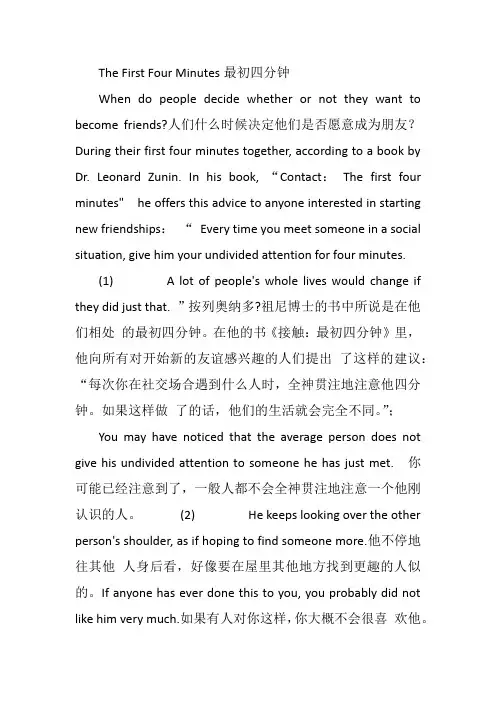
The First Four Minutes最初四分钟When do people decide whether or not they want to become friends?人们什么时候决定他们是否愿意成为朋友?During their first four minutes together, according to a book by Dr. Leonard Zunin. In his book, “Contact:The first four minutes" he offers this advice to anyone interested in starting new friendships:“Every time you meet someone in a social situation, give him your undivided attention for four minutes.(1) A lot of people's whole lives would change if they did just that. ”按列奥纳多?祖尼博士的书中所说是在他们相处的最初四分钟。
在他的书《接触:最初四分钟》里,他向所有对开始新的友谊感兴趣的人们提出了这样的建议:“每次你在社交场合遇到什么人时,全神贯注地注意他四分钟。
如果这样做了的话,他们的生活就会完全不同。
”;You may have noticed that the average person does not give his undivided attention to someone he has just met. 你可能已经注意到了,一般人都不会全神贯注地注意一个他刚认识的人。
(2) He keeps looking over the other person's shoulder, as if hoping to find someone more.他不停地往其他人身后看,好像要在屋里其他地方找到更趣的人似的。
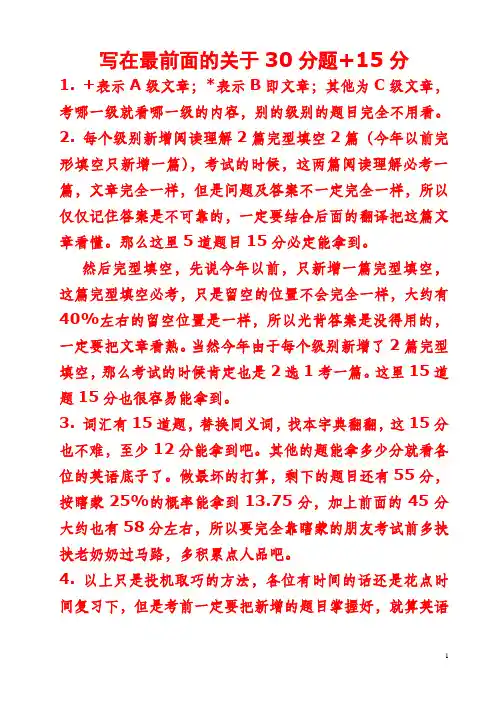
写在最前面的关于30分题+15分1. +表示A级文章;*表示B即文章;其他为C级文章,考哪一级就看哪一级的内容,别的级别的题目完全不用看。
2. 每个级别新增阅读理解2篇完型填空2篇(今年以前完形填空只新增一篇),考试的时候,这两篇阅读理解必考一篇,文章完全一样,但是问题及答案不一定完全一样,所以仅仅记住答案是不可靠的,一定要结合后面的翻译把这篇文章看懂。
那么这里5道题目15分必定能拿到。
然后完型填空,先说今年以前,只新增一篇完型填空,这篇完型填空必考,只是留空的位置不会完全一样,大约有40%左右的留空位置是一样,所以光背答案是没得用的,一定要把文章看熟。
当然今年由于每个级别新增了2篇完型填空,那么考试的时候肯定也是2选1考一篇。
这里15道题15分也很容易能拿到。
3. 词汇有15道题,替换同义词,找本字典翻翻,这15分也不难,至少12分能拿到吧。
其他的题能拿多少分就看各位的英语底子了。
做最坏的打算,剩下的题目还有55分,按瞎蒙25%的概率能拿到13.75分,加上前面的45分大约也有58分左右,所以要完全靠瞎蒙的朋友考试前多扶扶老奶奶过马路,多积累点人品吧。
4. 以上只是投机取巧的方法,各位有时间的话还是花点时间复习下,但是考前一定要把新增的题目掌握好,就算英语底子好的朋友也起码可以节约不少考试时间。
5. 本人职称英语A\B\C级都是这样考过的,每年的规律都是一样的。
从客观角度说,每年的职称英语考试书都不便宜,新增的内容也不多,如果新增的东西里面没有价值,那么那本书还有谁买?那本书可是考试中心出的,亲!最后,祝大家考试顺利!2012年职称英语理工类新增文章阅读理解(6篇)……………………3页第六篇 Making Light of1 Sleep第十九篇 Graphene's Superstrength1*第三+八篇 "Life Form Found" on Saturn's Titan*第四十篇 Teaching Math, Teaching Anxiety+第四+五篇 Teaching Math, Teaching Anxiety+第四十六篇Ants Have Big Impact on Environment as "Ecosystem Engineers"完形填空(6篇)……………………20页第三篇 Germs on Banknotes第十篇 Chicken Soup for the Soul:Comfort Food Fights Loneliness *第十一篇 Climate Change Poses Major Risks for Unprepared Cities*第十二篇 Free Statins With Fast Food Could Neutralize Heart Risk+第十三篇 Solar Power without Solar Cells+第十五篇“Liquefaction” Key to Much of Japanese Earthquake Damage注:1、+表示A级文章;*表示B即文章;其他为C级文章;2、阅读理解,请参见第3页;完形填空,请参见第20页;3、2012年词汇部分与2011年教材相比未作任何变化。
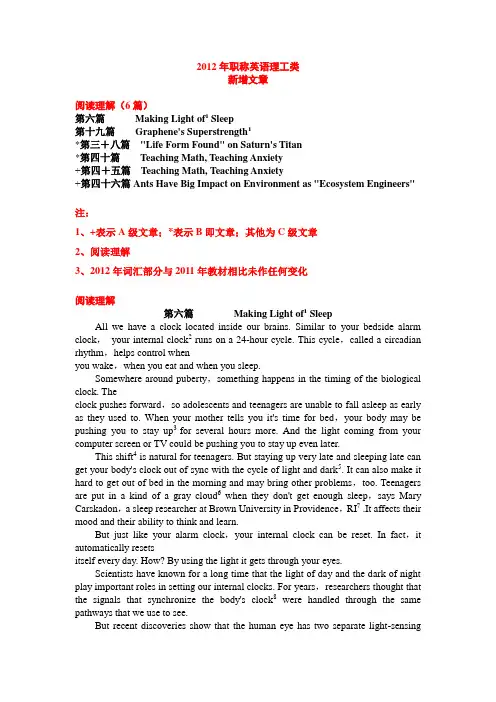
2012年职称英语理工类新增文章阅读理解(6篇)第六篇Making Light of1 Sleep第十九篇Graphene's Superstrength1*第三+八篇"Life Form Found" on Saturn's Titan*第四十篇Teaching Math, Teaching Anxiety+第四+五篇Teaching Math, Teaching Anxiety+第四十六篇Ants Have Big Impact on Environment as "Ecosystem Engineers" 注:1、+表示A级文章;*表示B即文章;其他为C级文章2、阅读理解3、2012年词汇部分与2011年教材相比未作任何变化阅读理解第六篇Making Light of1 SleepAll we have a clock located inside our brains. Similar to your bedside alarm clock,your internal clock2 runs on a 24-hour cycle. This cycle,called a circadian rhythm,helps control whenyou wake,when you eat and when you sleep.Somewhere around puberty,something happens in the timing of the biological clock. Theclock pushes forward,so adolescents and teenagers are unable to fall asleep as early as they used to. When your mother tells you it's time for bed,your body may be pushing you to stay up3 for several hours more. And the light coming from your computer screen or TV could be pushing you to stay up even later.This shift4 is natural for teenagers. But staying up very late and sleeping late can get your body's clock out of sync with the cycle of light and dark5. It can also make it hard to get out of bed in the morning and may bring other problems,too. Teenagers are put in a kind of a gray cloud6when they don't get enough sleep,says Mary Carskadon,a sleep researcher at Brown University in Providence,RI7 .It affects their mood and their ability to think and learn.But just like your alarm clock,your internal clock can be reset. In fact,it automatically resetsitself every day. How? By using the light it gets through your eyes.Scientists have known for a long time that the light of day and the dark of night play important roles in setting our internal clocks. For years,researchers thought that the signals that synchronize the body's clock8were handled through the same pathways that we use to see.But recent discoveries show that the human eye has two separate light-sensingsystems. One system allows us to see. The second system tells our body whether it's day or night.词汇:circadian/s3:'keidiən/ adj. 昼夜节奏的,生理节奏的adolescent/ædəu'lesənt/ n.青少年;adj.青少年的puberty/ 'pju:bəti/ n.发育;青春期sync/siŋk/ n. (口语)同步;和谐,协调synchronize/'siŋkrənaiz / V.(使)同时发生;(使)同步注释:1.make light of :轻视,不在乎。
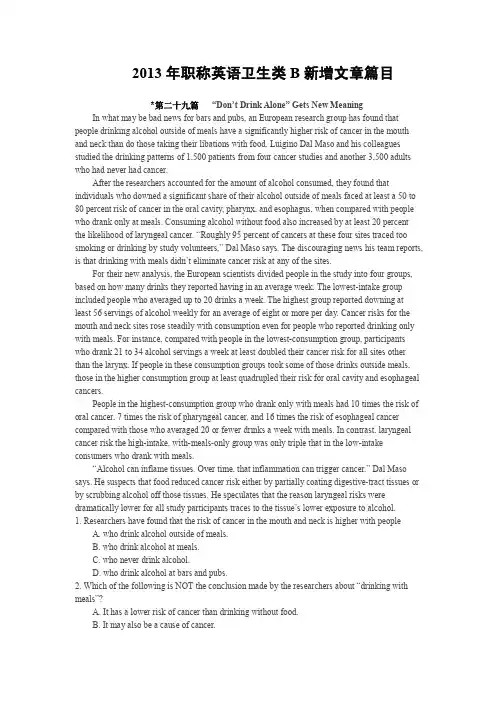
2013年职称英语卫生类B新增文章篇目*第二十九篇“Don’t Drink Alone” Gets New Meaning In what may be bad news for bars and pubs, an European research group has found that people drinking alcohol outside of meals have a significantly higher risk of cancer in the mouth and neck than do those taking their libations with food. Luigino Dal Maso and his colleagues studied the drinking patterns of 1,500 patients from four cancer studies and another 3,500 adults who had never had cancer.After the researchers accounted for the amount of alcohol consumed, they found that individuals who downed a significant share of their alcohol outside of meals faced at least a 50 to 80 percent risk of cancer in the oral cavity, pharynx, and esophagus, when compared with people who drank only at meals. Consuming alcohol without food also increased by at least 20 percent the likelihood of laryngeal cancer. “Roughly 95 percent of cancers at these four sites traced too smoking or drinking by study volunteers,” Dal Maso says. The discouraging news his team reports, is that drinking with meals didn’t eliminate cancer risk at any of the sites.For their new analysis, the European scientists divided people in the study into four groups, based on how many drinks they reported having in an average week. The lowest-intake group included people who averaged up to 20 drinks a week. The highest group reported downing at least 56 servings of alcohol weekly for an average of eight or more per day. Cancer risks for the mouth and neck sites rose steadily with consumption even for people who reported drinking only with meals. For instance, compared with people in the lowest-consumption group, participants who drank 21 to 34 alcohol servings a week at least doubled their cancer risk for all sites other than the larynx. If people in these consumption groups took some of those drinks outside meals, those in the higher consumption group at least quadrupled their risk for oral cavity and esophageal cancers.People in the highest-consumption group who drank only with meals had 10 times the risk of oral cancer, 7 times the risk of pharyngeal cancer, and 16 times the risk of esophageal cancer compared with those who averaged 20 or fewer drinks a week with meals. In contrast, laryngeal cancer risk the high-intake, with-meals-only group was only triple that in the low-intake consumers who drank with meals.“Alcohol can inflame tissues. Over time, that inflammation can trigger cancer.” Dal Maso says. He suspects that food reduced cancer risk either by partially coating digestive-tract tissues or by scrubbing alcohol off those tissues. He speculates that the reason laryngeal risks were dramatically lower for all study participants traces to the tissue’s lower exposure to alcohol.1. Researchers have found that the risk of cancer in the mouth and neck is higher with peopleA. who drink alcohol outside of meals.B. who drink alcohol at meals.C. who never drink alcohol.D. who drink alcohol at bars and pubs.2. Which of the following is NOT the conclusion made by the researchers about “drinking with meals”?A. It has a lower risk of cancer than drinking without food.B. It may also be a cause of cancer.C. It increases by 20 percent the possibility of cancer in all sites.D. It does not eliminate cancer risk at any of the sites.3. Approximately how many drinks do the lowest-intake group average per day?A. 3 drinks .B. 8 drinks.C. 20 drinksD. 50 drinks.4. Which cancer risk is the lowest among all the four kinds of cancer mentioned in the passage?A. Oral cancerB. Laryngeal cancerC. Pharyngeal cancerD. Esophageal cancer5. According to the last paragraph, tissue's lower exposure to alcoholA. explains why inflammation triggers cancer.B. accounts for why food can coat digestive-tract tissues.C. is the reason why food can scrub alcohol off tissues.D. reduces the risk of laryngeal cancer.答案与题解.1. A文章第一个句子就是答案。
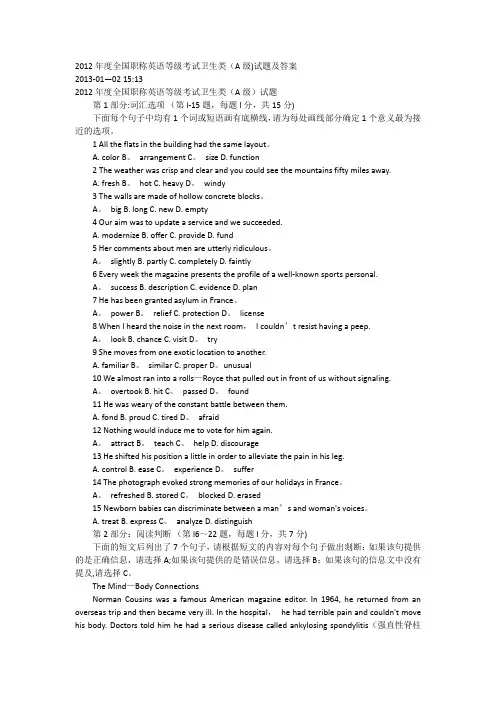
2012年度全国职称英语等级考试卫生类(A级)试题及答案2013-01—02 15:132012年度全国职称英语等级考试卫生类(A级)试题第1部分:词汇选项(第l-15题,每题l分,共15分)下面每个句子中均有1个词或短语画有底横线,请为每处画线部分确定1个意义最为接近的选项。
1 All the flats in the building had the same layout。
A. color B。
arrangement C。
size D. function2 The weather was crisp and clear and you could see the mountains fifty miles away.A. fresh B。
hot C. heavy D。
windy3 The walls are made of hollow concrete blocks。
A。
big B. long C. new D. empty4 Our aim was to update a service and we succeeded.A. modernizeB. offerC. provideD. fund5 Her comments about men are utterly ridiculous。
A。
slightly B. partly C. completely D. faintly6 Every week the magazine presents the profile of a well-known sports personal.A。
success B. description C. evidence D. plan7 He has been granted asylum in France。
A。
power B。
relief C. protection D。
license8 When I heard the noise in the next room,I couldn’t resist having a peep.A。

2012年职称英语变化二、2012年教材新增文章(一)阅读判断1.第七篇:Moderate Earthquake Strikes England2.*第十一篇:Computer Mouse(二)概括大意与完成句子1.第六篇:How We Form First Impression2.第十篇:Washoe Learned American Sign Language(三)阅读理解1.第一篇:Telling Tales about People2.第八篇:The Changing Middle Class3.第十篇:A Letter from Alan4.第十一篇:The Development of Ballet5.第十六篇:The Sahara 6.*第十七篇:Eiffel Is an Eyeful(2011年教材中为C级文章)7.*第十八篇:Goal of American Education(2011年教材中为C级文章)8.*第十九篇:The Family9.*第二十篇:Tales of the Terrible Past10.*第二十一篇:Spacing in Animals(2011年教材中为C级文章)11.*第二十二篇:Some Things We Know about Language(2011年教材中为C级文章)12.*第二十三篇:The Only Way Is Up(2011年教材中为C级文章)13.*第二十四篇:Clone Farm(2011年教材中为C级文章)14.*第二十五篇:Income(2011年教材中为C级文章)15.*第二十六篇:Seeing the World Centuries Ago16.*第二十七篇:Importance of Services(2011年教材中为C级文章)17.*第二十八篇:The National Park Service(2011年教材中为C级文章)18.*第二十九篇:Find Yourself Packing It On? Blame Friends(2011年教材中为C级文章)19.*第三十篇:"Lucky" Lord Lucan - Alive or Dead20.*第三十三篇:Oseola McCarty21.+第三十四篇:To Have and Have Not22.+第三十五篇:Going Her Own Way23.+第三十六篇:A Tale of Scottish Rural Life(2011年教材中为B级文章)24.+第三十七篇:Pop Music in Africa25.+第三十八篇:Why So Many Children26.+第三十九篇:Eat to Live(2011年教材中为B级文章)27.+第四十篇:Narrow Escape(2011年教材中为B级文章)28.+第四十七篇:Narrow Escape(四)补全短文1.第九篇:Heat Is Killer2.*第十一篇:Virtual Driver(五)完形填空1.第一篇:A Life with Birds2.第二篇:S Lucky Break3.第三篇:Global Warming4.第四篇:A Success Story5.第五篇:Traffic in Our Cities6*.第六篇:Teaching and Learning 7.*第七篇:The Difference between Man and Computer8.*第八篇:Look on The Bright Side9.*第九篇:The First Bicycle10.*第十篇:Working Mothers11.+第十一篇:School Lunch12.+第十二篇:A Powerful Influence13.+第十三篇:The Old Gate14.+第十四篇:Family History15.+第十五篇:Helen and Martin温馨提示:每年教材中新增篇幅的考试几率非常大,是考试复习的重点!职称英语2012年考试全解析】一、职称英语考试难度自1996年推出职称英语考试,根据人事考试网提供的数据来看,全国每年的通过率平均在60%左右。
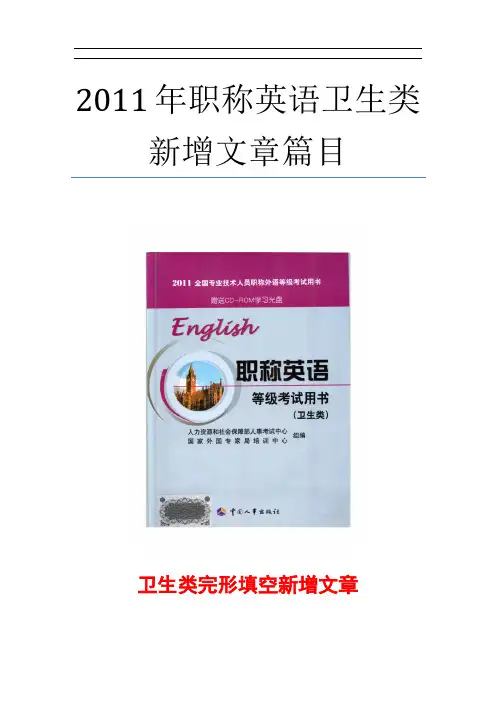
2011年职称英语卫生类新增文章篇目卫生类完形填空新增文章篇目第二篇Influenza*第七篇Exercise*第八篇Food Safety and Foodborne Illness+第十二篇Pandemic H1N11 2009第二篇InfluenzaInfluenza has been with us a long time.According___1_____ some Greek writers on medical history,the outbreak of 412 B.C.was of influenza.The same has been suggested of the sickness that swept through l the Greek army_____2_____ Syracuse in 395 B.C. Flu is a disease that moves most quickly among people____3____ in crowded conditions,hence,it is likely to attack armies.During the nineteenth century there were five widespread__4__ of influenza.The last of the five_____5_____ in l889 and marked the beginning of the story of influenza in our time.Like the_____6_____started in Asia.For more than forty years before that outbreak,influenza had steadily__7__ and was believed to be dying out.2A new group of outbreaks was introduced by the great outbreak of l889-1890 and for the next quarter of a century flu ____8____ a constant threat.In April 1918 flu broke out3 among American troops stationed in France.It quickly spread through all the armies but caused relatively____9____deaths.Four months later,____10____,a second outbreak started which proved to be a killer. It killed not only the old and already sick but also____11_____young adults.It went through4every country in the world,only a few distant islands in the South Atlantic and the Pacific remaining____12 ____.It brought the life of whole countries_____l3____,food supplies stopped and work loss was very great.Before the great outbreak ended,it___l4___ at least l5 million people.Thereafter there have been several great outbreaks throughout the world.It is thus____15_____ that influenza is a terrible infection that we have to pay more attention to.词汇:Influenza n.流行性感冒Outbreak n.爆发Syracuse n.叙拉古(意大利西西里岛东南部一海港)Widespread 普遍的,散布很广的steadily adv.稳定地quarter n.四分之一constant 妨经常发生的troop (常用复数)军队,部队station vt.驻扎’Atlantic adj".大西洋的;n.(the Atlantic)大西洋Pacific adj.太平洋的;n.(the Pacific)太平洋Thereafter adv.此后,其后注释:1.sweep through:席卷,横扫2.die out:消失,不复存在3.break out:突然发生;爆发4.go through:走遍练习:1.A at B to C in D from2.A being attacked B having been attacked C attacked D attacking 3.A sitting B standing C living D appearing 4.A outbreaks B incidents C accidents D cases5.A changed B happened C arise D descend6.A it B they C which D those7.A enlarged B strengthened C decreased D increased 8.A was no 1onger B went out of C ceased to be D reamained 9.A few B many C countless D innumerable 10.A in addition B however C therefore D moreover 11.A weak B disabled C sick D healthy 12.A touching B touched C untouched D having touched 13.A stop B stopping C stopped D to stop14.A killed B has killed C had killed D has been killing 15.A clear B strage C uncertain D questionable 答案与题解:1.B 四个选项中只有to可以与according连用,意为“根据,按照”,与上下文意思吻合。
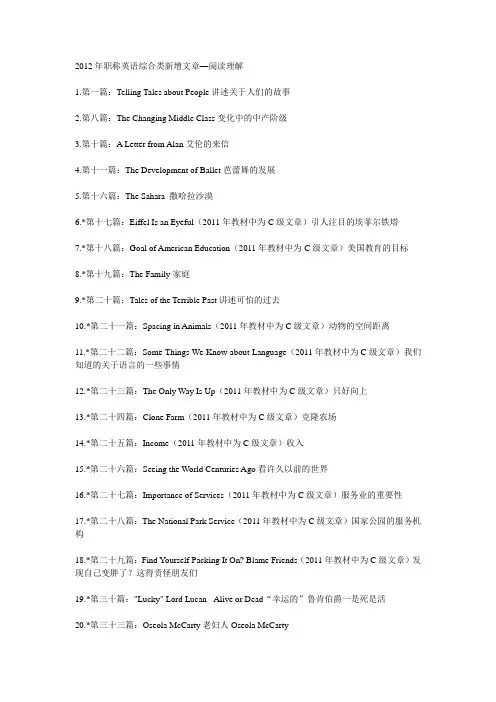
2012年职称英语综合类新增文章—阅读理解1.第一篇:Telling Tales about People讲述关于人们的故事2.第八篇:The Changing Middle Class变化中的中产阶级3.第十篇:A Letter from Alan艾伦的来信4.第十一篇:The Development of Ballet芭蕾舞的发展5.第十六篇:The Sahara 撒哈拉沙漠6.*第十七篇:Eiffel Is an Eyeful(2011年教材中为C级文章)引人注目的埃菲尔铁塔7.*第十八篇:Goal of American Education(2011年教材中为C级文章)美国教育的目标8.*第十九篇:The Family家庭9.*第二十篇:Tales of the Terrible Past讲述可怕的过去10.*第二十一篇:Spacing in Animals(2011年教材中为C级文章)动物的空间距离11.*第二十二篇:Some Things We Know about Language(2011年教材中为C级文章)我们知道的关于语言的一些事情12.*第二十三篇:The Only Way Is Up(2011年教材中为C级文章)只好向上13.*第二十四篇:Clone Farm(2011年教材中为C级文章)克隆农场14.*第二十五篇:Income(2011年教材中为C级文章)收入15.*第二十六篇:Seeing the World Centuries Ago看许久以前的世界16.*第二十七篇:Importance of Services(2011年教材中为C级文章)服务业的重要性17.*第二十八篇:The National Park Service(2011年教材中为C级文章)国家公园的服务机构18.*第二十九篇:Find Yourself Packing It On? Blame Friends(2011年教材中为C级文章)发现自己变胖了?这得责怪朋友们19.*第三十篇:"Lucky" Lord Lucan - Alive or Dead“幸运的”鲁肯伯爵一是死是活20.*第三十三篇:Oseola McCarty老妇人Oseola McCarty21.+第三十四篇:To Have and Have Not逃亡22.+第三十五篇:Going Her Own Way选择她自己的路23.+第三十六篇:A Tale of Scottish Rural Life(2011年教材中为B级文章)一个关于苏格兰乡村生活的故事24.+第三十七篇:Pop Music in Africa非洲的流行音乐25.+第三十八篇:Why So Many Children为什么有这么多的孩子26.+第三十九篇:Eat to Live(2011年教材中为B级文章)为了活着吃饭27.+第四十篇:Narrow Escape(2011年教材中为B级文章)美国疾病预防新政策28.+第四十七篇:Narrow Escape九死一生第一篇Telling Tales about PeopleOne of the most common types of nonfiction, and one that many people enjoy reading, is stories about people's lives. These stories fall into three general categories: autobiography, memoir, and biography.An autobiography is the story of a person's life written by himself or herself. Often it begins with the person's earliest recollections and ends in the present. Autobiography writers may not be entirely objective in the way they present themselves. However, they offer the reader a good look at the way they are and what makes them that way. People as diverse as Benjarmin Franklin and Helen Keller have written autobiographies. 1Other writers, such as James Joyce,have written thinly fictionalized accounts of their lives. These are not autobiographies,but they are very close to it.Memoirs, strictly speaking, are autobiographical accounts that focus as much on the events of the times as on the life of the author. 2Memoir writers typically use these events as backdrops for their lives. They describe them in detail and discuss their importance. Recently,though,the term memoir seems to be becoming interchangeab1e with autobiography. A memoir nowadays may or may not deal with the outside world.Biographies are factual accounts of someone else's life. In many senses,these may be the hardest of the three types to write. Autobiography writers know the events they write about because they lived them. But biography writers have to gather information from as many different sources as possible. Then they have to decide which facts to include. Their goal is to present a balanced picture of a person,not one that is overly positive or too critical. A fair well-presented biography may take years to research and write.词汇:backdrop /'b k,dr?p/ n. 背景interchangeable /int? 't?end??bl/ adj. 可转换的注释:1. People as diverse as Benjamin Franklin and Helen Keller have written autobiographies. 就像本杰明富兰克林和海伦凯勒一样,各种各样的人们已经写了自传。
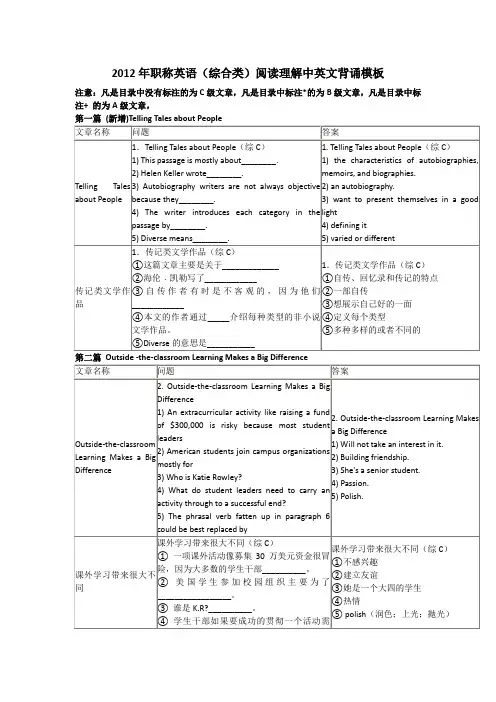
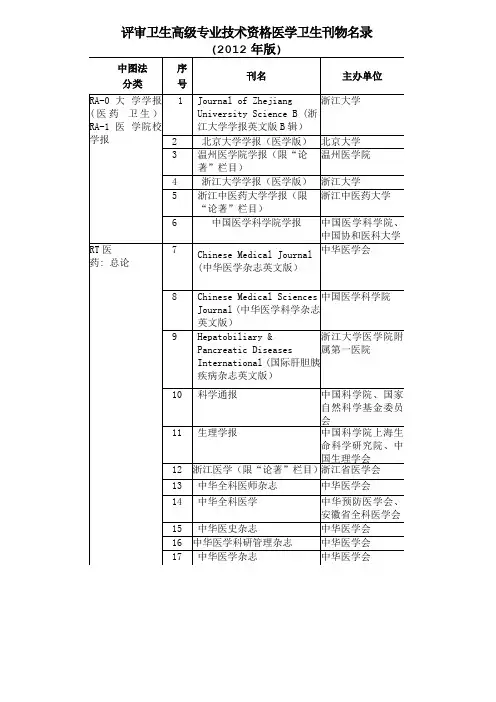
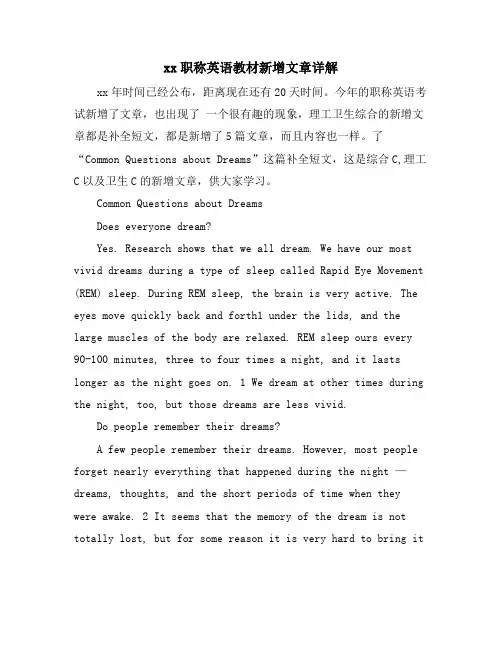
xx职称英语教材新增文章详解xx年时间已经公布,距离现在还有20天时间。
今年的职称英语考试新增了文章,也出现了一个很有趣的现象,理工卫生综合的新增文章都是补全短文,都是新增了5篇文章,而且内容也一样。
了“Common Questions about Dreams”这篇补全短文,这是综合C,理工C以及卫生C的新增文章,供大家学习。
Common Questions about DreamsDoes everyone dream?Yes. Research shows that we all dream. We have our most vivid dreams during a type of sleep called Rapid Eye Movement (REM) sleep. During REM sleep, the brain is very active. The eyes move quickly back and forth1 under the lids, and the large muscles of the body are relaxed. REM sleep ours every 90-100 minutes, three to four times a night, and it lasts longer as the night goes on. 1 We dream at other times during the night, too, but those dreams are less vivid.Do people remember their dreams?A few people remember their dreams. However, most people forget nearly everything that happened during the night —dreams, thoughts, and the short periods of time when they were awake. 2 It seems that the memory of the dream is not totally lost, but for some reason it is very hard to bring itback2. If you want to remember your dream,the best thing to do is to write it down as soon as you wake up.Are dreams in color?Most dreams are in color. However, people may not be aware of it for two reasons :They don’t usually remember the d etails of their dreams, or they don’t notice the color because it is such a natural part of our lives. 3Do dreams have meaning?Scientists continue to debate this issue.3 4 Some people use dreams to help them learn more about their feelings, thoughts, behavior, motives, and values. Others find that dreams can help them solve problems. It’s also true that artists, writers, and scientists often get creative ideas from dreams.How can I learn to understand my dreams?The most important thing to remember is that your dreams are personal. The people, actions, and situations in your dreams reflect your experience, your thoughts, and your feelings. Some dream experts believe that there are certain types of dreams that many people have,even if they e from different cultures or time periods. Usually, however, the same dream will have different meanings for different people. For example, an elephant in a dream may mean one thing to a zookeeper and something very different to a child whosefavorite toy is a stuffed elephant. 5 Then look for links between your dreams and what is happening in your daily life. If you think hard and you are patient, perhaps the meaning of your dreams will bee clearer to you.词汇:vivid /'vivid/ adj. 清晰的,生动的,逼真的lid /lid/ n. 眼睑(=eyelid)motive /m?utiv/n. 动机stuffed /st?ft/adj. 填充的,塞满了的注释:1. back and forth:来回地,反复地。
2015年全国职称英语考试卫生类类新增文章汇总word版全网独一份注:押题皇后王霞老师授意,新增文章仍然是考试热门文章,务必掌握。
2015年职称英语教材卫生类的变动比较小,一共只有5篇新增文章。
2015年职称英语教材卫生类新增的5篇文章,分布在阅读判断、阅读理解和补全短文:阅读判断综合A新增一篇文章;阅读理解卫生C新增一篇文章;补全短文卫生A、B和C各新增一篇文章。
完形填空卫生类整体都没有新增文章。
2015年卫生类职称英语教材新增文章的对比目录如下:旧文章新增文章卫生C 阅读理解第五篇:U.S. Eats Too Much Salt第五篇:Tracking Down HIV补全短文第二篇:Bedwetting第二篇:The Hope Children’sHospice卫生B 补全短文第七篇:Reinventing the Table第七篇:Powering Napping isGood for the I.Q卫生A 阅读判断第十二篇:First Self-contained HeartImplanted第十二篇:Inquest told ofhospital error补全短文第十二篇 More Efforts Urged toEmpower Women at AIDSConference第十二篇:The enemy Within卫生A补全短文新增文章+第十二篇The Enemy WithinAllergy has become more and more common over the last 30 years. Now one-third of us are affected by allergy at some point in our lives and half of these sufferers are children. In the UK, three million people suffer from asthma,and five per cent of children suffer from food allergy.Allergy is a reaction that occurs when the immune system has a strange and unnecessary reaction to a substance which is normally harmless, such as pollen or peanuts. ____1____ To defend your body against an attacker, the immune system remembers these dangerousmicro-organisms and attacks them if it meets them again. This work is done by antibodies. The immune system in allergy sufferers makes antibodies against harmless substances, because it mistakenly believes them to be dangerous.An allergic reaction may not happen the first time a sufferer meets an allergen (the substance causing the reaction,such as pollen,milk or strawberries). Sometimes people can eat nuts for years and then suddenly become allergic to them. What has happened is that the immune system has now decided the substance is dangerous and has made an allergy antibody. This antibody then attaches itself to cells, which contain histamine. ____2____As they do that, the surface of the cells is broken, and histamine is released. The histamine and other chemicals inflame the tissues. This leads to thesymptoms of allergy, such as swelling, rashes, sneezing, sore eyes and breathlessness. Anaphylaxis is the most severe allergic reaction of all and is most often triggered by wasp or bee stings or peanuts. This must be treated immediately.____3____ Some people are born with the ability to make lots of allergy antibodies, and they are more likely to develop allergies and allergic disorders such as hay fever and asthma.____4____ We eat more processed foods, with a wide range of additives and colourings; more and more people have central heating and double glazing, making our houses warmer and less draughty-an ideal environment to breed the house dust mite.There may also be a link between allergies and antibiotics. At one time our immune systems were kept busy fighting off disease and trying to win the battle for health, but antibiotics have reduced the amount of work our immune systems have to do. Now experts think theymay direct spare energy to harmless substances such as strawberries. ____5____A good deal of research is being devoted to finding a cure for allergies. Sufferers may be given medicine to control symptoms, and they may also be offered tests to find out what substances trigger an allergic reaction so that they can avoid contact with these in future.词汇:allergy n. 过敏,过敏症sufferer n.患者,受害者asthma n.哮喘substance n.物质pollen n.花粉micro-organism n.微生物antibodies n. antibody的复数形式,意为抗体allergen n.过敏源nut n.坚果histamine n.组织胺,组胺tissue n.人体组织symptom n.病症,征兆rash n.疱疹sneezing n.打喷嚏breathlessness n.呼吸急促,气喘吁吁anaphylaxis n.全身性过敏反应,过敏反应wasp n.黄蜂sting n.蟄,咬hayfever n.枯草热,花粉病additives n.添加剂,食品添加剂cure n.治疗,解药注释:1.suffer from...忍受^的折磨2.be devoted to sth. ...全身心投入于^练习:AThe immune system is there to protect the body against outside attackers, including viruses, bacteria and parasites.BIn other words our immune systems have become over-sensitive.CAllergies run in families.DInternational differences have been associated with the number of individuals within a population have allergy.EWhen the antibodies meet the allergen the next time, they attempt to destroy it.FExperts believe more people have developed allergies because of changes in our lifestyle which have exposed us to more allergens.答案与题解:1.A该是对机体免疫系统功能的介绍,而文中对免疫系统的首次提及是在该选项的上一句话,即描述过敏反应是免疫系统的活动,该选项故而可被视为是对上一句话的补充与说明。
2012 年职称英语综合类新增文章—阅读理解To Have and Have Not It had been boring hanging about the hotel all afternoon. The road crew were playing a game with dollar notes. Folding them into small planes to see whose would fly the furthest.I having nothing better to do,I joined in and won five,and then took the opportunity to escape with my profit. Despite the evil-looking clouds,I had to get out for a while.I headed for a shop on the other side of the street. Unlike the others,it didn't have a sign shouting its name and business,and instead of the usual impersonal modern lighting,there was an appealing glow inside. Strangely nothing was displayed in the window. Not put off by this,I went inside. It took my breath away. I didn't know where to look, where to start. On one wall there hung three hand-stitched American quilts that were in such wonderful condition they might have been newly-made. I came across tin toys and antique furniture, and on the wall in front of me, a 1957 Stratocaster guitar , also in excellent condition. A card pushed between the strings said $50. I ran my hand along a long shelf of records, reading their titles. And there was more... ―Can I help you?‖She startled me. I hadn't even seen the woman behind the counter come in. The way she looked at me, so directly and with such power. It was a look of such intensity that for a moment I felt as if I were wrapped in some kind of magnetic or electrical field.I found it hard to take and almost turned away. But though it was uncomfortable. I was fascinated by the experience of her looking straight into me, and by the feeling that I was neither a stranger, nor strange, to her. Besides amusement her expression showed sympathy. It was impossible to tell her age;she reminded me faintly of my grandmother because, although her eyes were friendly, I could see that she was not a woman to fall out with. I spoke at last. 'I was just looking really,' I said, though secretly wondering how much of the stuff I could cram into the bus. Thewoman turned away and went at once towards a back room, indicating that I should follow her. But it in no way lived up to the first room. The light made me feel peculiar, too. It came from an oil lamp that was hung from the centre of the ceiling and created huge shadows over everything. There were no rare electric guitars, no old necklaces, no hand-painted boxes with delicate flowers. It was also obvious that it must have taken years, decades, to collect so much rubbish, so many old documents arid papers. I noticed some old books, whose gold lettering had faded, making their titles impossible to read. 'They look interesting,' I said, with some hesitation. 'To be able to understand that kind of writing you must first have had a similar experience,' she said clearly. She noted the confused look on my face, but didn't add anything. She reached up for a small book which she handed to me. 'This is the best book I can give you at the moment,' she laughed. ―If you use it.‖I opened the book to find it full. or rather empty, with blank white pages, but paid her the few dollars she asked for it, becoming embarrassed when I realised the notes were still folded into little paper planes. I put the book in my pocket, thanked her and left. 词汇:impersonal /im'p?:s?n?l/ adj. 客观的;非个人的;没有人情味的;[语] 非人称的n.[语]非人称动词;不具人格的事物antique / n'ti:k/ adj. 古老的,年代久远的n. 古董,古玩startle /'st ɑ:tl/ vt. vi. 使吓一跳,使惊奇n.惊愕,惊恐arid / ' rid/ adj. 干旱的,枯萎的。
2012年职称英语理工、综合和卫生教材(电子版已经发布,欢迎下载)完形填空(6篇)第三篇Germs on Banknotes第十篇Chicken Soup for the Soul:Comfort Food Fights Loneliness*第十一篇Climate Change Poses Major Risks for Unprepared Cities*第十二篇Free Statins With Fast Food Could Neutralize Heart Risk+第十三篇Solar Power without Solar Cells+第十五篇“Liquefaction” Key to Much of Japanese Earthquake Damage注:1、+表示A级文章;*表示B即文章;其他为C级文章2、阅读理解3、2012年词汇部分与2011年教材相比未作任何变化第三篇Germs on BanknotesPeople in different countries use different types of 1 yuan in China, pesos in Mexico, pounds in the United Kingdom, dollars in the United States, Australia and New Zealand. They may use 2 currencies, but these countries, and probably all countries, still have one thing in common1: Germs on the banknotes.Scientists have been studying the germs on money for well over2 100 years. At the turn of the 20th 3 , some researchers began to suspect that germs living on money could spread disease.Most studies of germy money have looked at the germs on the currency 4 one country. In a new study, Frank Vriesekoop3 and other researchers compared the germ populations found on bills of different 5 .Vriesekoop3 is a microbiologist at the University of Ballarat in Australia4. He led the study, which compared the germ populations found on money 6 from 10 nations. The scientists studied 1,280 banknotes in total; all came from places where people buy food, like supermarkets street vendors and cafes, 7 those businesses often rely on cash.Overall, the Australian dollars hosted the fewest live bacteria ---- no more than 10 per square centimeter. Chinese yuan had the most ---- about 100 per square centimeter. Most of the germs on money probably would not cause harm.What we call “paper” money usually isn't made from paper. The U. S. dollar, for example, is printed on fabric that is mostly 8 .Different countries may use different 9 to print their money. Some of the currencies studied by Vriesekoop and his 10 such as the American dollar were made from cotton. Others were made from polymers.The three 11 with the lowest numbers of bacteria were all printed on polymers. They included the Australian dollar, the New Zealand dollar and some Mexican pesos.The other currencies were printed on fabric made 12 of cotton. Fewer germs lived on the polymer notes. This connection suggests that 13 have a harder time staying alive on polymer surfaces. Scientists need to do more studies to understand how germs live on money-----and whether or not we need to be concerned. Vnesekoop is now starting a study that will 14 the amounts of time bacteria can stay alive on different types of bills.Whatever Vriesekoop finds, the fact remains: Paper money harbors germs We should wash our 15 after touching it; after all5, you never know where your money 's been. Or what's living on it词汇:pesos/pi:səvs/ n .比索bacterium /kæk'tiəriəm/ n .细菌(单数)germ/dʒə:m/ n.病菌bacteria /bæktiəriə/细菌(复数)banknote/bæŋknəvt/ n.纸币centimeter/senti,mi:tə。
2010年职称英语考试(卫生类)完型填空新增文章-书中第2篇第二篇New York Students Have Swine FluThe Centers for Disease Control and Prevention has confirmed 1 of swine flu in eight students at a New York preparatory school, Mayor Michael Bloomberg said Sunday. The students have had only 2 symptoms and none have been hospitalized, he said. Some of the students have already recovered.More than 100 students were absent from 3 due to flu-like symptoms last week. New York health officials tested samples for eight students Saturday and determined the students were probably 4 from swine flu, and the CDC confirmed the 5 on Sunday, Bloomberg said.The announcement brings the 6 of confirmed swine flu cases in the United States to 20. Bloomberg and New York Health Commissioner Tom Frieden said there is no 7 of a citywide outbreak of the flu, and no sign of a potential 8 of swine flu at other schools.Some students at the school 9 spring break1 in Mexico, Bloomberg said,but authorities have not determined 10 any of the students with a confirmed case of swine flu was in Mexico. Someone who traveled to Mexico may not have had any flu symptoms but 11 on the flu to someone else, he noted.Frieden called 12 students who are home sick to stay home for 48 hours after their symptoms subside.If symptoms are normal for a regular kind of flu, there is 13 need to go to a hospital, said Bloomberg. If symptoms become severe, as with any 14 , people should go to the hospital, he said.St. Francis, which has 2,700 students, announced it will remain closed for two days. 15 whether the students' illnesses have been minor because they're young and healthy or because it is a minor strain of the virus, Frieden responded, "We don't know."词汇swine n.猪preparatory adj. 预备教育的,预科的outbreak n. 爆发subside v. 消失,消退strain (菌)株,(菌)系注释1. spring break: (美)春假(在校生复活节期间一周的假期)练习1. A cases B bases C does D noses2. A common B physical C mild D wild3. A work B home C school D hospital4. A escaping B surviving C dying D suffering5. A treatment B diagnosis C doubt D choice6. A point B number C spread D value7. A chance B need C hope D sign8. A welcome B outbreak C success D injury9. A spent B made C took D traveled10. A why B how C when D whether11. A passed B kept C rolled D swept12. A at B up C on D of13. A no B much C any D a14. A person B matter C thing D illness15. A Asked B Tested C Troubled D Doubted答案与题解1. A 从短文的题目可以看出,纽约有8 名学生患了猪流感,所以此处应为流感病例。
2011年卫生类职称英语教材新增文章阅读理解新增文章(共4篇)目录:第三篇(C级):Cooking Oil Fumes Cause Tumor第十八篇(B级):Exercise Can Replace Insulin for Elderly Diabetics第二十四篇(B级):Preventing Chlid Maltreatment第三十四篇(A级):Be Alert to Antimicrobial Resistance第三篇Cooking Oil Fumes Cause TumorThe leading cause of lung cancer among women in the city was cooking oil fumes while men are more likely to develop the disease from smoking,said medical experts after a five-year research study.Doctors announced the results yesterday with analysis on some new tendencies in lung cancer. They said patients are younger,especially women.According to the Shanghai Tumor research Institute,more local residents die of lung cancer in the city than anything else. Following breast cancer,it has the second-highest incidence rate.“An unhealthy lifestyle is a very important reason for lung cancer,”said Dr He Yumin from Shanghai Minshen Traditional Chinese Medicine Tumor Diagnosis and Treatment Center.He followed 2,276 lung cancer patients for five years. Among them,1,483 were male.Smoking causes 70 percent of cases among men while only 18 percent of female patients developed cancer from smoking or inhaling second-hand smoke,according to the report.However,more than 60 percent of women with the disease had long term,close contact with strong oil fumes from cooking and complained about l irritated eyes and throat.About 32 percent of women fried foods in boiling oil in unventilated kitchens and about 25 percent of women’s bedrooms were adj acent to2 the kitchen.However,local women were surprised to learn cooking oil fumes could lead to cancer. Some claimed they may change food preparation methods.“Unless my family and I don't eat at home every day,I must stay in the kitchen to cook," said Xu Li. a 45-year-old local woman. "I know the fumes are bad for the skin,but it is the first time I heard that it can result in lung cancer .I have already started frying less.’’Doctors said women’s lung cancer had few links to personal health and p hysical condition,but was closely related to family cancer history,unhealthy dietary habits and weak immune systems.Other experts agreed with He.3"Smoking is by far the biggest cause4 of lung cancer for men," said Dr Tan Binyong, honorary president of the Respiratory Disease Institute at Fudan University's Medical College. "It's true that second-hand smoke and cooking fumes are the main causes among women.”He's research also warned people not to stand near of stalls selling5 fried foods due to the poor quality of oils used.The chance of catching lung cancer is three times higher if exposed to the fume for a long time,6 experts said.词汇:fume n.烟,气,汽fry v.油炸,油煎tumor(=tumour)n.肿瘤unventilated vt.使不通风cancern.癌瘤adjacent adj.临近的breast/brest/n.乳房,胸dietary adj饮食的incidence n.发生(率) immune adj 免疫的diagnosis n.诊断honorary adj.名誉上的;荣誉的inhale v.吸人respiratory adj.呼吸的irritate vt.使疼痛,刺激stall n.货摊注释:plain原意是“抱怨,诉苦”,但医学上常用complain about或complain of表示“主诉"。
2012年职称英语卫生类新增文章篇目职称英语外语教育网2011-12-272012年职称英语卫生类新增文章篇目阅读理解第八篇Eat Healthy第十九篇Prolonging Human Life*第二十四篇Sleep Lets Brain File Memories+第三十四篇Who Want to Live Forever?+第四十篇Some People Do Not Taste Salt Like Others 完形填空第二篇Going on a diet (18)注:1、+表示A级文章;*表示B即文章;其他为C级文章;2、完形填空请参见第#页;2第八篇Eat Healthy"Clean your plate!" and "Be a member of the clean-plate -club!" Just about every kid in the US has heard this from a parent or grandparent. Often,it's accompanied by an appeal:" Just think about those starving orphans in Africa!" Sure, we should be grateful for every bite of food. Unfortunately, many people in the US take too many bites. Instead of staying "clean the plate", perhaps we should save some food for tomorrow.According to news reports, US restaurants are partly to blame for the growing bellies. A waiter puts a plate of food in front of each customer, with two to four times the amount recommended by the government, according to a USA Today story. Americans traditionally associate quantity with value and most restaurants try to give them that. They prefer to have customers complain about too much food rather than too little.Barbara Rolls, a nutrition professor at Pennsylvania State University, told USA Today that restaurant portion sizes began to grow in the 1970s, the same time that the American waistline began to expand.Health experts have tried to get many restaurants to serve smaller portions. Now, apparently,some customers are calling for this too. The restaurant industry trade magazine QSR reported last month that 57 percent of more than 4,000 people surveyed believe restaurants serve portions that are too large;23 percent had no opinion; 20 percent disagreed. But a closer look at the survey indicates that many Americans who can't afford fine dining still prefer large portions. Seventy percent of those earning at least $150,000 per year prefer smaller portions; but only 45 percent of those earning less than $25,000 want smaller.It's not that working class Americans don't want to eat healthy. It's just that,after long hours at low-paying jobs,getting less on their plate hardly seems like a good deal. They live from paycheck to paycheck ,happy to save a little money for next year's Christmas presents.词汇:orphan /''?:f?n] / n.孤儿belly /'beli/ n.肚子3nutrition / nju:'tri??n / n.营养waistline / 'weistlain / n.腰围paycheck / 'pei't?ek / n.薪金支票注释:1. Be a member of the clean - plate club! 做清盘俱乐部的成员2. Just think about those starving orphans in Africa! 只要想想在非洲挨饿的孤儿们!3. take too many bites 吃得太多4. A Waiter puts a plate of food in front of each customer,with two to four times the amount recommended by the government, according to a USA Today story. 根据《今日美国》刊登的一个故事,服务员给每个顾客一盘饭菜,其量是政府推荐的2至4倍。
5. It's just that, after long hours at low-paying jobs, getting less on their plate hardly seems like agood deal. 事情是这样的,美国工人觉得做许多个小时低收入的工作下来,盘子里的饭菜量小有点不合算。
练习:1. Parents in the United States tend to ask their childrenA to save food.B to wash the dishes.C n ot to waste food.D not to eat too much2. Why do American restaurants serve large portions?A Because Americans associate quantity with value.B Because Americans have big bellies.C Because Americans are good eaters.D Because Americans are greedy.3. What happened in the 1970s?A T he US government recommended the amount of food a restaurant gave to a customer.B H ealth experts persuaded restaurants to serve smaller portions.C T he United States produced more grain than needed.D The American waistline started to expand.4. What does the survey indicate?A Many poor Americans want large portions.B T wenty percent Americans want smaller portions.C F ifty seven percent Americans earn $150 ,000 per year.D Twenty three percent Americans earn less than $25,000 per year.5. Which of the following is Not true of working class4Americans?A T hey work long hours.B They live from paycheck to paycheck.C T hey don't want to be healthy eaters.D They want to save money for their children答案与题解:1. C 本题问的是:美国父母总是叫他们的孩子干什么?文章开头说到,每个美国孩子都能从父母或爷爷奶奶那里听到这样的话,"吃光你盘子里的东西","做清盘俱乐部的成员"。
这些话表达的意思就是不要浪费粮食。
因此 C 是正确的答案。
2. A 本题问的是:美国饭馆为什么饭菜给得多?第二段相关的话是这么说的:美国人在传统上把东西值不值是跟数量联系在一起,因此大多数的饭馆给的量大。
这些饭馆乐于让顾客们抱怨饭菜给得太多而不乐于让他们抱怨饭菜给得太少。
所以 A 是正确的答案。
3. D 本题问的是:20 世纪70 年代发生了什么?文章第三段是这样说的:一位宾州大学营养教授,Barbara Rolls ,告诉《今日美国》20 世纪70 年代饭馆给的饭菜的量开始增加,与此同时,美国人的腰围也开始增大。